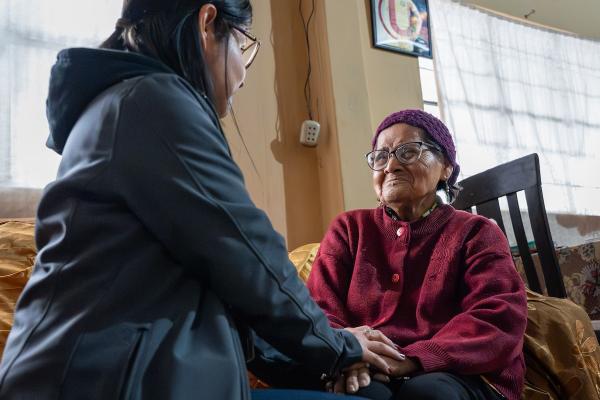Before she turned 80, Olga Ijuma began to lose her appetite, and then, little by little, the will to get out of bed. Her husband’s death had opened a rift that was hard to close, but it was the diagnosis of pulmonary fibrosis that ultimately aggravated her mental health.
“My mom thought the worst: that she had cancer, that she was going to die suddenly,” recalls Claudia, her third daughter, who has since taken care of her.
Confinement due to the pandemic deepened that isolation. Olga, who for years had been a community health worker - used to going around her district of Carabayllo, listening and accompanying others - suddenly found herself locked up, without a routine to sustain her. It wasn’t until this year that she was able to name what she had been feeling for some time: depression.
“I spent a lot of time alone,” she says.
The situation began to change when she joined an initiative of the Mental Health Partners In Health (SES) program, inspired by the international Do More, Feel Better model. The project helps seniors resume activities that give them meaning and pleasure, as a way to restore mood and reduce sadness.
Through the accompaniment of trained volunteers - in this case, community health workers - each participant finds support to get moving again, share and reconnect with their environment.

Depression in the elderly: an invisible problem
Among the elderly, depression often arrives silently. It is mistaken for fatigue or the natural passing of the years, but behind that apparent calm lies a malaise that is rarely named. During the pandemic, isolation and disruption of routines exacerbated that emotional fragility, according to studies by the U.S. National Institute of Health.
In Peru, where nearly 14% of the population is over the age of 60, depression in the elderly represents an urgent public health challenge. Family losses, physical deterioration and lack of support networks increase the risk, while difficulties in accessing specialized services prolong suffering in silence. An estimated 2 in 10 older people go on to have suicidal thoughts, a figure that reveals the magnitude of the problem and the urgency of addressing it from the community.
“In response to this, we are incorporating behavioral activation through the Kusi Tayta project,” explains Margot Aguilar, head of the project in the SES Mental Health program. “It consists of nine sessions developed by community health agents in the homes of the elderly. We seek to reduce depressive symptoms by helping them reconnect with meaningful activities in their daily lives.”
It is estimated that 2 in 10 older people come to have suicidal thoughts.
Olga Ijuma met Socios En Salud thanks to one of her daughters, who receives care for a severe mental disorder. It was during one of those visits that the team approached her about participating in the new intervention.
Every week, a community health worker would come to her house, sit down with her and ask her how she was feeling. Sometimes Olga would respond wearily; sometimes with a faint smile. “She would ask me how I was doing, if I’d had a good day or if something was bothering me,” she recalls. “Over time, I began to feel calmer, more cheerful. It was nice to have someone to visit me, to talk to me. I didn’t feel so lonely anymore.”
In addition to talking, her companion would leave her small tasks: solving pupiletras, drawing, doing some art. Simple activities that gradually restored rhythm and purpose to her days. Olga began to get up earlier, to prepare in advance for visits, to rediscover the pleasure of reading or attending meetings at the senior center in her area.

A life that moves again
Today, Olga, a fan of Universitario de Deportes, is once again looking forward to the matches of the team she loves. He also continues to fill his pupiletras with the same dedication as before, as if every word found was a small victory.
“I wake up eager to do things, to fulfill the tasks that are left to me,” she says. “I like to be responsible, so I prepare ahead of time. I feel like I have a reason to start the day.”
“She’s been advised quite a bit to think about herself, to give herself her place and not carry everything that’s going on around her,” her daughter comments. “That has helped her a lot. Now I see her stronger, calmer. She doesn’t let herself be defeated so easily anymore.”
In that gesture - that of having everything ready, of getting back on the move, of cheering on her team - there is more than discipline: there is a silent, but firm, form of hope.
